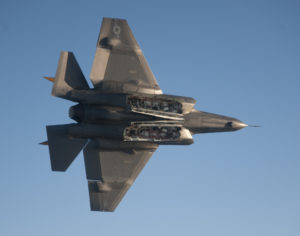Russian and Chinese weapon systems have made leaps and bounds in the last decade, in some cases, even popping up overnight. One area in particular that’s causing concern is the countries’ air-to-air missile capabilities, where the U.S. Air Force (USAF) is seemingly dragging its feet.
Recent reports surfaced suggesting that the Chinese have a new very-long-range air-to-air missile (VLRAAM), one that could hit U.S. Aircraft at twice the range of today’s missiles, before they could even shoot back. The missile has a speed of Mach-6 (Hypersonic) which is twice as fast as the U.S.’s newest AIM-120D missile, currently being tested on the F-22.
What’s holding the USAF back from surpassing the Chinese and Russians in air to air capabilities? It’s certainly not the lack of knowledge by weapons engineers in the U.S. To answer that question go back to March 2017, when a group of engineers at the Naval Air Warfare Center Weapons Division were able to create a ramjet missile in less than 6-months. The engineers used nothing more than a credit card and $900 dollars’ worth of off-the-shelf model rocket parts. This was done to avoid the usual “time-consuming defense acquisition process.” The inability to stay small, buy cheap, test often, and avoid the usual time-consuming processes could be the reason the US has fallen behind. The need to take air superiority more seriously should be a top concern for the U.S.
While the U.S. has taken air superiority for granted over the years, recent advancements of Russian and Chinese Air to Air missiles are not only threatening F-35’s and F-22’s but they also are putting key refueling tankers and ISR assets within range. The 2008 RAND briefing suggests that in order for the U.S. Air Force to sustain operations over Taiwan, they would need to launch 3 to 4 tanker sorties per hour to deliver 2.6 million gallons of fuel to support fighters launched from Guam. A fact that has not likely escaped Beijing’s notice, says Dave Mujumdar of the National Interest. Read more below.
Thus, with the information available, it is likely that Russian and Chinese deployment of long-range air-to-air missiles—and the fifth-generation fighters to carry those weapons—could pose a significant problem for the Pentagon. It’s a problem that certainly bears watching in the coming years.
A new generation of Russian and Chinese-built long-range air-to-air missiles could threaten the critical nodes that enable U.S. air operations. Those nodes include the AWACS, various intelligence, surveillance and reconnaissance (ISR) assets, aerial refueling tankers and electronic attack aircraft.
While often overlooked in favor of advanced anti-ship and surface-to-air missile systems when examining Russian and Chinese anti-access/area denial (A2/AD) capabilities, such long-range air intercept weapons—coupled with the right fighter—could cut the sinews that allow the United States to conduct sustained air operations in both the Asia-Pacific and the European theatres. Essentially, Russians and/or Chinese forces could pair long-range air-to-air missiles with aircraft like the Mikoyan MiG-31 Foxhound, Sukhoi T-50 PAK-FA and the Chengdu J-20 to attack American AWACS, JTARS and aerial refueling tankers like the Boeing KC-135 or forthcoming KC-46 Pegasus. Especially over the vast reaches of the Pacific where airfields are few and far between, lumbering aerial refueling tankers could be an Achilles’ Heel that Beijing could chose to exploit. There are three long-range air-to-air missile programs that bear watching—the Russian Vympel R-37M RVV-BD, the Novator KS-172 (aka K-100) and the Chinese PL-15. […]
Indeed, the problem is not just that the PL-15 would out-range the AMRAAM, when coupled with the J-20, the Chinese could attack the tankers and ISR aircraft that would be the key enablers during any air campaign over the Pacific. A 2008 RAND briefing suggested that in order to sustain F-22 operations over Taiwan from Guam, the U.S. Air Force would need to launch three to four tanker sorties per hour to deliver 2.6 million gallons of fuel. That’s a fact that has not likely escaped Beijing’s notice.
While there is not much concrete data available about the J-20, the aircraft appears to have been optimized to high-speeds, long-range, stealth and a heavy internal payload. With a combination of reduced radar cross-section and high supersonic speed—armed with internally carried PL-15 missiles—it is possible that the J-20 could be used to threaten U.S. Air Force tankers and ISR assets in the Pacific theatre. As pointed out in the 2008 RAND study—Chinese derivatives of the Su-27 Flanker all but annihilated U.S. tanker, ISR, maritime patrol and command and control aircraft during a simulation using long-range air-to-air missiles.
The U.S. Air Force has looked at dispersed basing and developing robust logical trains to supply those austere airstrips to counter China’s A2/AD capabilities in the Pacific theatre. However, the Air Force does not appear to have fully developed a plan to protect its tanker, ISR and command and control assets from enemy air attacks. The only answer the service has to the problem is that those aircraft will have to be pulled back to safety outside the effective range of the Chinese threat. However, that would also shorten the effective range of the Pentagon’s short-range tactical fighters—reducing their ability to strike deep inside Chinese territory.
Thus, with the information available, it is likely that Russian and Chinese deployment of long-range air-to-air missiles—and the fifth-generation fighters to carry those weapons—could pose a significant problem for the Pentagon. It’s a problem that certainly bears watching in the coming years.
Source: The National Interest





